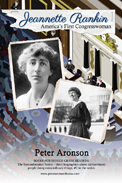
 |
This second book in The Groundbreaker Series for middle-grade readers is a biography of Jeannette Rankin, America’s first congresswoman, who was elected in 1916. Born in Montana in 1880, Rankin’s pioneering spirit is evident throughout her early life on her family’s ranch where her parents instilled strong values and then later at college where she begins to set a course for her life that is not a traditional trajectory toward marriage and family. Instead, she begins to seek career opportunities in social work and eventually becomes a leading suffrage advocate working tirelessly to push for a woman’s right to vote. As a congresswoman, she solidifies a legacy of pacifism, casting a vote against entering World War I and World War II.
Rankin was recognized throughout her life for her work as a feminist and for her anti-war activism. Her life story is inspiring and relevant for today’s young readers looking for historical role models. Informative and interesting, Aronson illuminates the life of Rankin with this well-researched biography of her extraordinary life. Organized chronologically and sprinkled with black and white photographs, each stage of her life is filled out with details of her aspirations and ambitions to impact society and government. Young readers, parents, and educators can draw a direct line from Rankin’s life to the current wave of female congresswomen who made history in the 2018 midterm elections. This important book solidifies the historical record in the minds of young people who may be more familiar with famous feminist forbearers like Susan B. Anthony or Elizabeth Cady Stanton.
Rankin’s name deserves to be known and her life studied for the legacy she built to empower women. Her determination to have a voice in the decisions affecting all Americans but particularly women and children motivated her to run for office. In the current era of the #metoo movement and recent possible judicial and legislative impacts on women, the life of this important pioneer can serve as a model for public service and political power. Though some of her votes as the first female congresswoman were largely symbolic, having a voice in a room full of men still reverberates through time. Aronson describes the realities of the unfortunate timing of Rankin’s first vote—a vote against entering World War I. It was not a popular vote, and it was one she would repeat during World War II. But she held firm that she was representing the mothers of the country who would be sending husbands and sons to fight and die. She also felt that because she could not fight in the war as a woman, it was not fair to send someone else to fight. She stood her ground despite holding unpopular opinions about war and peace. Late in her life, she also joined the anti-war movement during the Vietnam era.
As Aronson chronicles these periods of Rankin’s life with rich detail, the story of her life leaps along with ease and superb readability. Aronson captures the quiet ambition of one woman propelled into the historic spotlight as she campaigns for a woman’s right to vote as a citizen and as a representative.
RECOMMENDED by the US Review